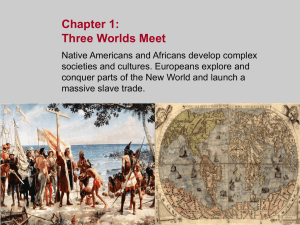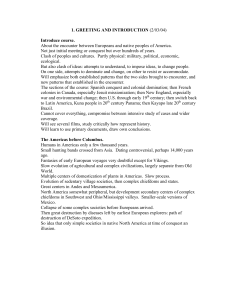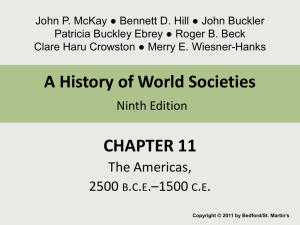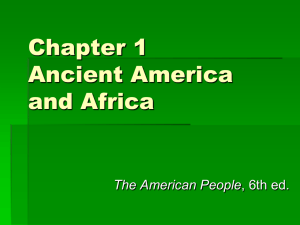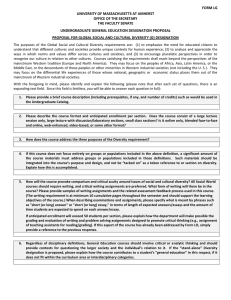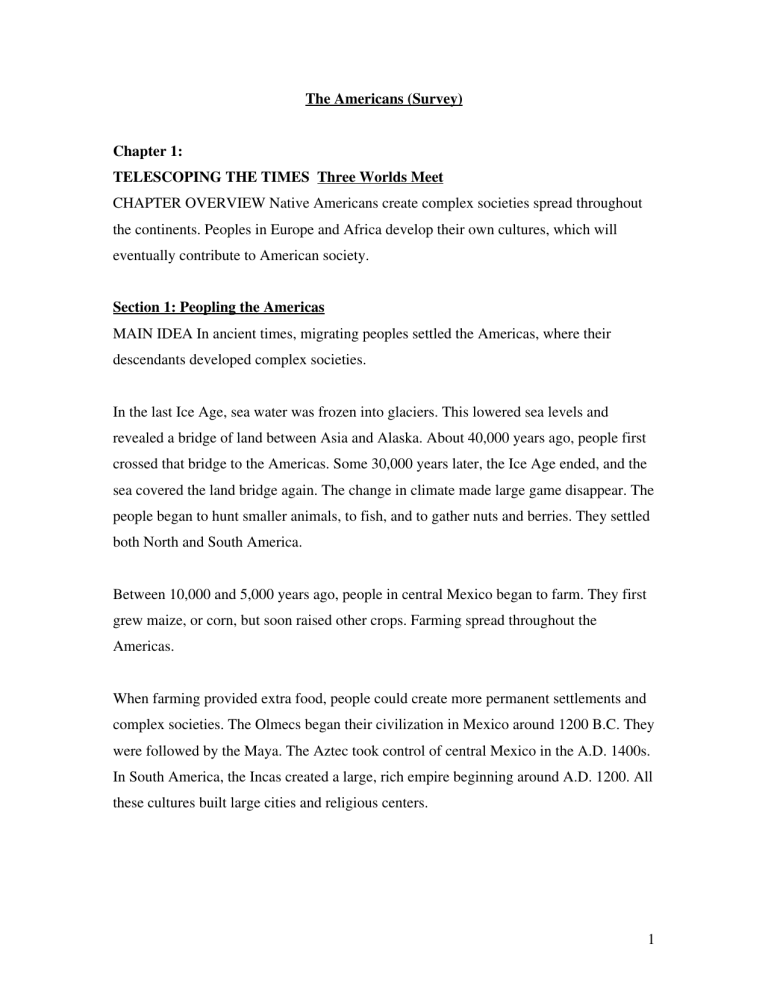
The Americans (Survey) Chapter 1: TELESCOPING THE TIMES Three Worlds Meet CHAPTER OVERVIEW Native Americans create complex societies spread throughout the continents. Peoples in Europe and Africa develop their own cultures, which will eventually contribute to American society. Section 1: Peopling the Americas MAIN IDEA In ancient times, migrating peoples settled the Americas, where their descendants developed complex societies. In the last Ice Age, sea water was frozen into glaciers. This lowered sea levels and revealed a bridge of land between Asia and Alaska. About 40,000 years ago, people first crossed that bridge to the Americas. Some 30,000 years later, the Ice Age ended, and the sea covered the land bridge again. The change in climate made large game disappear. The people began to hunt smaller animals, to fish, and to gather nuts and berries. They settled both North and South America. Between 10,000 and 5,000 years ago, people in central Mexico began to farm. They first grew maize, or corn, but soon raised other crops. Farming spread throughout the Americas. When farming provided extra food, people could create more permanent settlements and complex societies. The Olmecs began their civilization in Mexico around 1200 B.C. They were followed by the Maya. The Aztec took control of central Mexico in the A.D. 1400s. In South America, the Incas created a large, rich empire beginning around A.D. 1200. All these cultures built large cities and religious centers. 1 Between 300 B.C. and A.D. 1400, the Hohokam and Anasazi peoples had created civilizations in southwestern North America. Cultures east of the Mississippi River are called the Mound Builders for the large burial mounds they created. Section 2: North American Societies Around 1492 MAIN IDEA The varied landscapes of North America encouraged the diversity of Native American cultures. Native Americans developed different lifestyles, each adapted to a specific environment. The Kashaya Pomo hunted waterbirds along the coast of California. The Kwakiutl and peoples of the Northwest took food from the sea—whale, seal, and sea otter. The Pueblo and Hopi tribes of the Southwest lived in multi-story homes made of adobe, or baked clay. They lived near rivers and farmed. Native Americans of the east lived in vast woodlands and built villages in forest clearings. Those in the colder northeast relied on hunting. Those in the warmer southeast relied more on farming. Although Native American groups had many differences, they shared some traits. Trading networks enabled them to exchange goods over long distances. All Native American groups believed that land could be used but not owned. Most believed that spirits lived in the world. Some saw one of these spirits as the supreme creator or most powerful being. Native Americans had strong family ties. Most groups saw families in broad terms, including aunts, uncles, and cousins as well as parents and children. Older family members were valued for passing on their knowledge. Section 3: West African Societies Around 1492 MAIN IDEA West Africa in the 1400s was home to a variety of peoples and cultures. 2 West Africa by the 1400s had long been connected to the wider world through trade. A trading network connected most of West Africa to the coastal ports of North Africa and through these ports to markets in Europe and Asia. Cities at the crossroads of these trade routes became rich and powerful. Traders traveled across the Sahara to these West African cities, bringing goods and the Islamic faith. In the 1440s, traders from Portugal arrived off West Africa. Within a few decades, they had claimed two islands and begun plantations for growing sugar cane. The Portuguese bought slaves from the African mainland to work on these plantations. The Portuguese opened West Africa for the first time to direct trade with Europe. West Africa included three major kingdoms. The Songhai empire of the interior controlled trade across the Sahara. King Askia Mohammed made the city of Timbuktu a center of learning. The Benin kingdom dominated the area around the mouth of the Niger River. Farther south, the kingdom of Kongo was established on the lower reaches of the Zaire (Congo) River. Life in West Africa revolved around families clustered in small villages. Each family traced its lineage, or line of descent, and older people enjoyed high status. West African peoples believed that nature was full of spirits, and religious rituals were tied to everyday life. Most groups believed in the collective ownership of land. Work was divided by age and social rank. Some societies held slaves, and trade in slaves was a major part of the trading network. Section 4: European Societies Around 1492 MAIN IDEA Political, economic, and intellectual developments in western Europe in the 1400s led to the Age of Exploration. European societies were organized according to rank. Monarchs and nobles owned the land plus most of the wealth and power. Below them was a growing middle class of 3 merchants and artisans. At the bottom was a large body of peasants who raised crops and livestock. A major influence on Western European society was the Roman Catholic Church. The Church encouraged Christians to retake Spain from Muslims and to try to oust the Muslims in the Holy Land. The Crusades, a series of wars there, strengthened the power of European monarchs. They also caused an increase in trade and weakened the power of the church. The Protestant Reformation of the 1500s divided Christianity in Western Europe between Catholicism and Protestantism. Other changes swept Europe. Millions died in the 1300s from crop failures, disease, and wars. Soon, though, the European economy revived. The desire for products of Asia—especially spices—revived trade and generated new wealth. The population grew again, spurring more trade. Merchants gained wealth, and national monarchs gained power at the expense of nobles. New emphasis on people as individuals arose in the movement called the Renaissance, and people began to seek fame for themselves. All these changes, plus advances in sailing technology, prompted interest in exploration. Europeans sought water routes to the east. They wanted to avoid long overland journeys through Muslim-controlled land. By the 1480s, the Portuguese had sailed around Africa to India. Christopher Columbus then persuaded Spain’s Queen Isabella to try another route: sailing west. Section 5: Transatlantic Encounters MAIN IDEA Columbus’s voyages set off a chain of events that brought together the peoples of Europe, Africa, and the Americas. Columbus left Spain for Asia with three ships. On October 12, 1492, a lookout sighted land. Mistakenly thinking that he had reached Asia, Columbus called the people he encountered los indios—“Indians.” In later voyages, he, and other explorers, planted Spanish settlements. 4 Native Americans suffered from the harsh rule of the Spanish, who killed many and enslaved those who survived. Native Americans also suffered from the diseases that Europeans brought. With no immunity to smallpox, measles, mumps, and other diseases, hundreds of thousands died. The Spanish needed a new source of slave labor. They soon began importing West Africans as slaves. From the early 1500s to the early 1800s, at least 12 million West Africans were taken to the New World as slaves. This contact between the Old World and the New brought many changes in a process called the Columbian Exchange. The Americas introduced crops such as cassava, corn, tomatoes, and potatoes to the Old World. Europeans brought coffee, sugar, bananas, horses, cattle, and sheep from the Old World to the New. Life was transformed in both regions. Millions of Native Americans died, and millions of Europeans and Africans came to live in the Americas. 5

